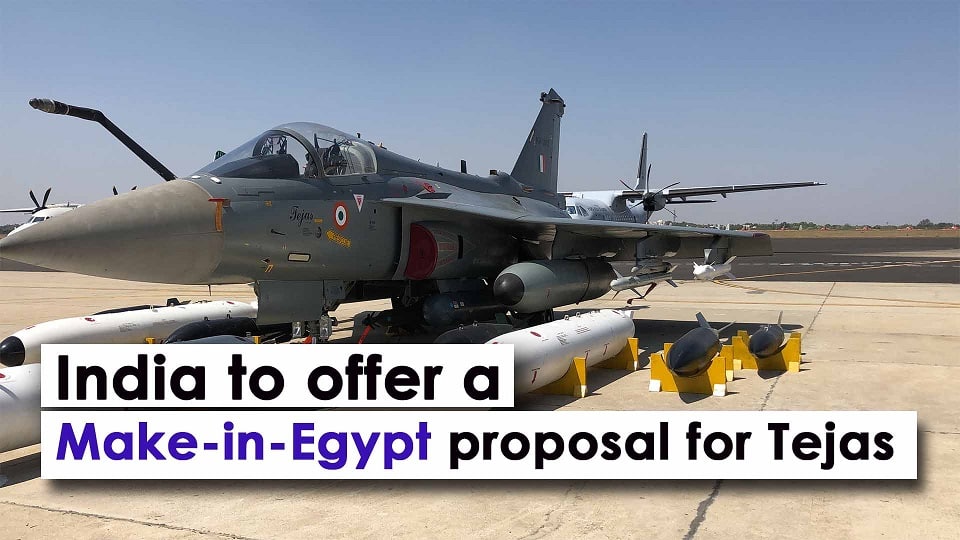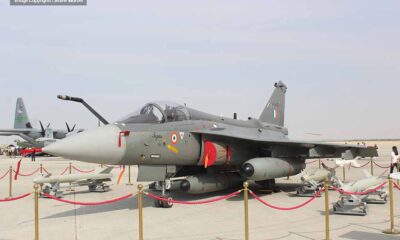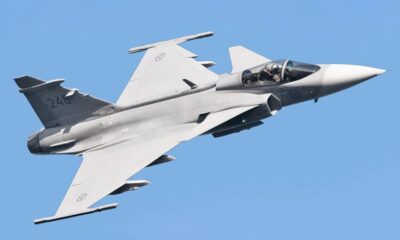Aerospace
India to offer a make-in-Egypt proposal for 70 Tejas planes?

The Indian Tejas is roaring high in capacity and power, and now HAL is attempting to offer a Tejas fighter aircraft deal to Egypt. It also intends to establish production facilities in Egypt for the manufacture of light combat aircraft (LCA) and helicopters as it seeks export prospects in the Middle East and North Africa region. Egypt is looking for a fleet of 70 aircraft in the LIFT category.
According to reports, the Egyptian Air Force head is scheduled to visit India in the coming days to inspect manufacturing and maintenance facilities.
Egypt is primarily interested in being the first to market with a fighter training aircraft variant based on the Tejas trainer airframe. The airframe will be stripped of high-end sensors and avionics but will incorporate training-specific cockpit equipment like as a Wide Area Display (WAD) to be utilized as an Advance Jet Trainer for inexperienced pilots before they move to Squadrons. The LIFT category aircraft assists pilots in becoming qualified before flying other fighters such as the Sukhoi 30 MKI, Rafale, or F16 fighter aircraft. The LIFT category aircraft is used for both training and combat purposes.
It boasts the most powerful air force fleet among emerging countries. Egypt’s air force has a mixed fleet of aircraft from China, Russia, the United States, and Europe, and it has recently placed orders for French Rafael fighters and Russian 35 fighters. It currently has approximately 220 f 16 fighters, 24 rafale, 15 mriage, and 46 mig 29 fighters.
HAL has the option of pushing the HTT 40 Hindustan Turbo Trainer aircraft, although this is still in the works. However, it will be advantageous to obtain a starting level trainer aircraft. HAL is contemplating an initial programme similar to the US Air Force’s T-X programme for a new-generation trainer aircraft produced by the SAAB-Boeing collaboration.
HAL is working hard to increase the number of export orders for TEJAS, and it confidently displayed the aircraft flying display in the Dubai and Singapore airshows. The aircraft is built on a sturdy airframe that has undergone extensive testing and has good avionics support. Tejas is now being upgraded to the Mark2 level for the Indian Air Force, which includes the latest avionics and weapon deployment capabilities.
The Royal Malaysian Air Force (RMAF) is the most promising potential customer, having bid for 18 light fighters with an option for another 18. This would be a welcome first export order for the Tejas.
HAL has provided the RMAF with the advanced Tejas Mark 1A fighter, which includes mid-air refueling, an AESA radar, electronic warfare (EW) capability, and the capacity to shoot BVR missiles. HAL is undergoing testing for the Malaysian-specified on-board oxygen generating system (OBOGS).
There is a considerable possibility that Tejas will outperform the other fighter capabilities and win the contract from Malaysia, but its government purchasing agency has yet to make a decision.

Aerospace
India is set to build a central command for the Air Traffic Control system, called ISHAN

India’s air traffic growth has led to increased responsibilities for air traffic control. The Airports Authority of India (AAI) is considering centralizing air traffic control for aircraft, dividing the country into four regions. The goal is to consolidate India’s segmented airspace into a single entity to improve air traffic management (ATM) efficiency, safety, and smoothness.
Recently, the AAI invited expressions of interest to develop a detailed project report for the Indian Single Sky Harmonized Air Traffic Management (ISHAN) initiative in Nagpur. Under this plan, air traffic controllers in Nagpur would handle domestic flights flying above 25,000 feet, eliminating the need for coordination among controllers in different regions.
For domestic regional flights operating above 25,000 feet, control would shift to the central command in Nagpur. This consolidation aims to enhance airline operations, increase flight handling capacity, and reduce congestion and flight times for passengers.
Currently, the AAI provides ATM services over Indian airspace and adjoining oceanic areas, covering over 2.8 million square nautical miles. This airspace is divided into four flight information regions (FIRs) in Delhi, Mumbai, Kolkata, and Chennai, along with a sub-FIR in Guwahati.
FIRs are responsible for providing air traffic services, including weather information, visibility, and search and rescue assistance. The proposed unification under the ISHAN initiative aligns with the projected growth of the aviation industry, which anticipates a doubling of domestic passenger traffic by 2030.
Aerospace
Does AirAsia show interest in Comac aircraft in the future?

Tony Fernandes, CEO of Capital A, operating as AirAsia Group, recently paid a visit to the facilities of COMAC on April 2, 2024, and was thoroughly impressed by what he witnessed.
C919 already securing nearly 1000 orders
COMAC, known for its homegrown aircraft, has launched two promising jets: the ARJ21 and the C919 aircraft. Both aircraft are gaining popularity in the Chinese market, with the C919 already securing nearly 1000 orders from various airlines.
Fernandes expressed his admiration for COMAC’s achievements in aircraft manufacturing, acknowledging the immense challenge it entails. His visit underscored the realization that AirAsia now has a viable third option when it comes to selecting aircraft for its fleet.
During his tour, Fernandes was delighted by the innovation and technology evident in COMAC’s aircraft production and the company’s commitment to long-term partnerships.
He noted that many Western companies have shifted away from prioritizing loyalty and customer service, opting instead for short-term gains and a narrow definition of success.
Last month, COMAC embarked on an international tour, showcasing demonstration flights to neighboring countries, particularly Indonesia and Malaysia. Fernandes believes that the positive impression left by COMAC during his visit opens up new opportunities for collaboration.
Fernandes emphasized COMAC’s remarkable achievements
The shared values of loyalty, customer service, and long-term vision align closely with AirAsia’s ethos, making collaboration with COMAC appealing. With a focus on innovation and excellence, both companies stand to benefit from a partnership grounded in trust and a shared commitment to success.
Indonesia and China have already collaborated in validating and maintaining the airworthiness of the ARJ21 aircraft, indicating a solid foundation for future partnerships.
In his statement, Fernandes emphasized COMAC’s remarkable achievements and genuine desire for long-term partnership, highlighting the absence of ego and a genuine willingness to succeed together. He marveled at COMAC’s fully automated, AI-driven factory, a testament to their dedication to innovation and efficiency.
Fernandes criticized Western firms for prioritizing short-term gains over loyalty, customer service, and long-term strategy, emphasizing the importance of understanding customers’ needs and collaborating to achieve success.
Aerospace
Indigo will soon launch Air Taxi Service in India

InterGlobe Enterprises, the parent brand of IndiGo, is set to revolutionize travel in India with its upcoming air taxi service.
Scheduled for a potential launch in 2026, this innovative venture promises a seamless journey for passengers between two bustling hubs. Delhi and Gurgaon in Haryana. The forthcoming service is projected to revolutionize the daily commute, offering passengers a swift aerial journey covering the distance in a mere 7 minutes.
This remarkable efficiency contrasts starkly with the conventional 90-minute drive, underscoring the immense time-saving potential for commuters. The anticipated fare, ranging from Rs 2,000-3,000, makes this innovative mode of transport not only swift but also remarkably competitive in pricing.
At the heart of this ambitious endeavor lies a strategic partnership with Archer Aviation, a pioneer in electric vertical takeoff and landing (eVTOL) aircraft technology. Under this collaboration, Archer will supply 200 state-of-the-art eVTOL aircraft, representing an investment of US$ 1 billion. These cutting-edge aircraft, capable of accommodating up to four passengers alongside the pilot, epitomize the future of sustainable air travel.
Powered by six battery packs, Archer’s eVTOL aircraft boast rapid charging capabilities, enabling a swift turnaround between flights. With a charging time of just 30-40 minutes, these eco-friendly aircraft ensure minimal downtime, maximizing operational efficiency.
Similar services are anticipated to be introduced by the joint venture in Bengaluru and Mumbai as well. Nevertheless, the service rollout period has not yet been made public by the company. Next year, it is anticipated to get its certification. Following this, the company will start the certification procedure with the Directorate General of Civil Aviation (DGCA).





























